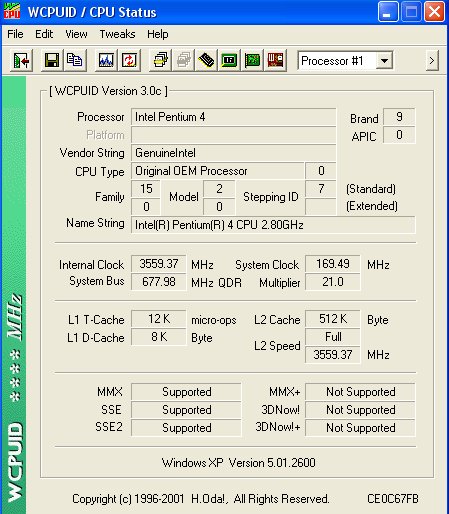Conclusion
The first aspect that I think deserves particular mention is the ease by which Intel have managed to raise the Pentium 4's clock speed. In recent times, processor speed increases have been kept to a modest 5% or so. Today we see a 2.8GHz processor replacing a 2.53GHz processor at the top of the Pentium 4 hierarchy. The 11% increase is impressive considering that no meaningful architectural changes have been implemented.
What's also pleasing about this particular processor is just how easily it still manages to exceed its rated speed. I was a little apprehensive after noting that it shipped with a raised default core voltage of 1.525v, but my apprehension turned into an almost sense of awe as the processor sat at 3.307GHz with a core, under-load voltage of only 1.61v, air-cooled. If this particular sample is considered to be a standard 2.8GHz CPU, and I have no reason to doubt it isn't, there is still plenty of headroom left in the Northwood 0.13u core.
Up until a week ago, the Pentium 4 was arguably the processor of choice for those that wanted ultimate performance. The 2.53GHz CPU usually saw off the challenges of the 1.8GHz Athlon XP2200 Thoroughbred without too much bother. The status quo changed rather abruptly last week as AMD announced a newer, faster core revision that enabled the XP to run at a blistering 2.133GHz. Its benchmarks rivaled, and often beat, those laid down by the 2.53GHz processor, especially in FPU-intensive tasks.
I wanted to put the P4 2.8GHz up against something that could hold its own against Chipzilla's latest and greatest. Seeing as the Athlon will be moving to a 166FSB shortly, I simply ran the XP2600+ at a lower multiplier and higher FSB (12.5x170, 2125MHz), to mimic its future performance.
In most of my benchmarks, even the artificially-enhanced Athlon XP could only manage to gain parity with the 2.8GHz P4, such is its basic speed. The overclocked P4 simply demolished any and every benchmark record that we have here at Hexus, 3.3GHz has that kind of effect on benchmarks, though. I purposely chose to benchmark with DDR-based systems for some kind of consistency.
The downside of every new processor, and especially Intel's CPU, is price. If previous CPU are anything to go by, we should see this 2.8GHz processor hit the UK market shortly at around the £500 - £550 mark. Would I personally spend that kind of money on one, even with its prodigious overclocking potential ?. The answer is probably no. The competing XP2600+ is slated to be introduced at around £250, so, as always, Intel will never win the price / performance crown.
The upside of a new processor release is that other CPU in the same family are normally recipients of a large price-cut. We're hearing that the 2.53GHz CPU will fall by around 60%, quite a saving on present prices. Even though I have focused on the 2.8GHz CPU, Intel also announce the availability of the 2.66GHz Pentium 4 processor.
I like this processor as it keeps pushing back the boundaries of what is possible. AMD have raised their game recently with their faster XPs, Intel have responded in no uncertain terms with, what is , arguably the fastest desktop CPU ever. The Empire does indeed strike back.
Highs
- Arguably the fastest desktop CPU available
- Impressive overclocking ability
- Its introduction will pave the way for present P4 prices to be slashed
Lows
- Price, obviously
- The performance delta between it and the XP series is narrowing rather quickly
Overall rating 8.5/10.
Afterthoughts
Even though a 3300MHz clock speed was supremely stable during testing, I wanted to see just how high I could get this processor. Armed with a dangerous amount of voltage and a Windows-based overclocking tool, this is what I got up to.

Incredibly unstable, but it does give us a glimpse of what we might expect from either current super-cooling, or upcoming Northwood processors. Kind of scary.
I would also like to thank Gavin Froude of Coolmods.com for his invaluable help during testing and benchmarking.
PS
Just one day after Intel's announcement of their new line of processors, we see them in stock and ready to go at larger American retailers. AMD's much-vaunted XP2600+ is still some time away from hitting retail shelves.













